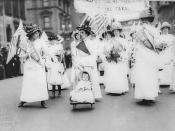Beginning in the early 1970s, the rights of women were widely recognised and their issues raised. The Australian Women's Movement came in response to the American movement made by 'feminists' who aimed to "revolutionise the way women were viewed and treated in society." This they did, marching and protesting, making the majority of the population aware of the challenges many women faced, in the workplace and in the broader society.
In reaction, many were shame-faced and decided to make laws preventing the continuance of such discrimination and disadvantage. The following laws were passed in response to the Australian Women's Liberation Movement:
Maternity Leave Act of 1973, giving women the right to leave their work to have children and return to it after the child has ceased to be an infant
Family Law Act of 1975 which first allowed a no-fault divorce, allowing women to escape from unloving or abusive marriages
Anti-Discrimination Act of 1977, making discrimination a punishable offence, aimed to include the discrimination of women
Equality of Status Children's Act of 1997 gave the same status to children born outside of wedlock as those of legitimate marriages
Sex Discrimination Act of 1984, a specialised Act to renounce all discrimination towards women as a result of their sex
Equal Opportunity for Women Act of 1986 which introduced the notion of affirmative action, to make any profession available to a woman
Since the time of the Womens Liberation, many people have been against what the marchers protested to gain.
Despite the rights that they today enjoy, many young women protest to the way by which the feminists procured those rights. They suggest that the action was too radical and has often caused men to be considered inferior to women as a result of their thorough political correctness.
Despite the objections...


